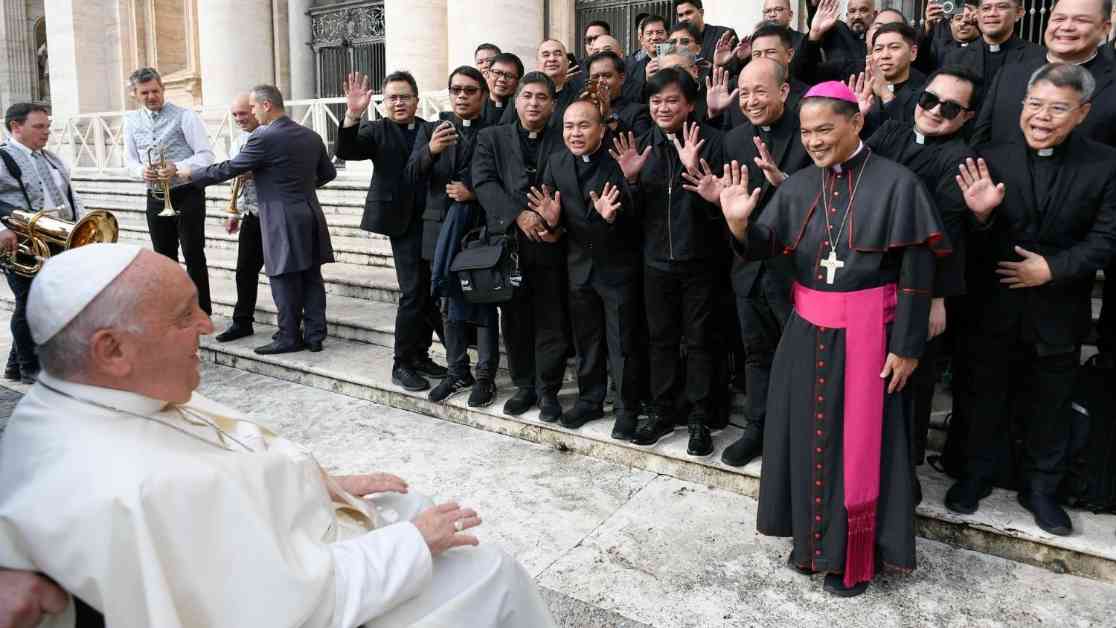Here is your article!
Pope Francis addressed the audience on October 9, 2024, at the Vatican’s audience hall. In his speech, he focused on the Holy Spirit and the Church, drawing references from the Acts of the Apostles. The account of the descent of the Holy Spirit at Pentecost begins with preparatory signs – the rushing wind and tongues of fire – and concludes with the statement: “And they were all filled with the Holy Spirit” (Acts 2:4). Luke, the author of Acts, emphasizes that the Holy Spirit ensures the universality and unity of the Church. The immediate result of being “filled with the Holy Spirit” is that the apostles “began to speak in other languages” and went out of the upper room to proclaim Jesus Christ to the crowd (cf. Acts 2:4ff). This highlights the universal mission of the Church as a sign of new unity among all peoples.
The Spirit works in two ways to create unity. On one hand, it pushes the Church outward to welcome more people and nations; on the other hand, it gathers them inward to strengthen the achieved unity. It teaches them to expand in universality and gather in unity. Universality and unity: That is the mystery of the Church. The first movement – universality – is seen in Acts 10, with the conversion of Cornelius. On the day of Pentecost, the apostles proclaimed Christ to all Jews and followers of the Mosaic Law, regardless of their nationality. It took another “Pentecost,” similar to the first one at the house of Cornelius, to prompt the apostles to broaden their horizons and overcome the final barrier between Jews and Gentiles.
In addition to ethnic expansion, there is geographical expansion. Paul, as recorded in Acts 16:6-10, wanted to preach the Gospel in a new region in Asia Minor but was prevented by the Holy Spirit. Instead, he was directed to go to Macedonia. The Gospel thus moved from Asia to Europe.
The second movement of the Holy Spirit – creating unity – is seen in Acts 15, during the Council of Jerusalem. The Holy Spirit does not always work for unity suddenly and miraculously, as at Pentecost. He also works discreetly, respecting time and human differences, through individuals, institutions, prayer, and dialogue. This happened at the Council of Jerusalem when addressing the obligations of converts from paganism to the Mosaic Law. The solution was announced to the whole Church with the words: “It has seemed good to the Holy Spirit and to us” (Acts 15:28).
Augustine describes the unity brought by the Holy Spirit with an analogy: “As the soul is to the human body, so is the Holy Spirit to the body of Christ, which is the Church.” This analogy helps us understand that the Holy Spirit does not impose unity from the outside; he does not simply command us to be united. He is the “bond of unity” himself.
The unity of the Church is a unity among people and is achieved not at the table but in life. We all desire unity from the bottom of our hearts, yet it is challenging to attain and maintain, even in marriage and family. The difficulty lies in each person seeking unity around their own standpoint, without considering that the other person is doing the same. This only drives unity further apart.
The Spirit teaches that the unity of Pentecost is achieved by striving to center on God instead of oneself. In this way, Christian unity is built: not by waiting for others to join where we are, but by moving together toward Christ. Let us ask the Holy Spirit to help us be instruments of unity and peace.

















